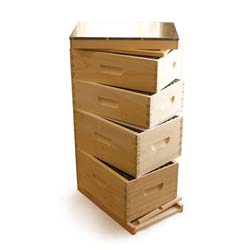A crucial responsibility for any beekeeper is completing regular (but not too frequent) beehive inspections. Opening your beehive and observing your colony’s activities and behaviors directly gives you invaluable insight into their health and can alert you to potential issues that may require your help as their keeper. Inspections are also a great way to relax and enjoy spending time with some awesome creatures as you listen to their buzz and watch as workers bring their foraged bounties back home.
Below, we’ll give you an overview of the most important things to focus on during your beehive inspections. But don’t forget that it helps quite a bit to plan for what you hope to see or do during each hive inspection before you put on your protective clothing, light the smoker, and head out to the bee yard!
You’ll first want to check for signs that there is a healthy and laying queen within the colony (and be sure she has plenty of room to do so). Closely look at each frame in the brood nest for a healthy brood pattern and note which stages of larval development you see, especially whether there are any newly laid eggs. Even without actually spotting the queen herself, seeing eggs will at least confirm that a laying queen was present within the last 3 days. Making sure she has enough room to lay eggs is essential, too, as colonies who don’t feel they have enough room for both rearing brood AND storing resources may decide they need to swarm and find a new home.
(Check out the “Read More” section below for additional resources and tips on managing hive capacity, queen spotting, and understanding the brood pattern.)
While confirming that a healthy queen is present and aiding in the colony’s reproduction is critical, there are other key aspects to help you monitor the colony’s overall well-being. In addition to inspecting the brood nest, take note of individual bee behaviors and anatomy, check for signs of diseases or other threatening pests (like varroa mites), and be sure that conditions inside the hive are optimal (such as moisture levels, in-hive temperatures, and ventilation). If natural food sources aren’t yet available and stored resources aren’t sufficient, you may need to help support them by providing a feeder with supplemental feed, which may be either a pollen substitute or carbohydrate source, like sugar syrup in early spring or candy boards in the cold months of winter.
It’s important to remember that completing the hive inspection is just part of the first step. To have a successful beekeeping season, you’ll need to also understand, remember (or document), and act on what is going on in and around your beehive. Taking notes (or photos) of what you see and any questions you come up with is crucial to not only planning future bee yard trips and hive inspections but in helping you understand your bees better in the long-term, too! Any records or photos you’ve taken of your colony can be shared with more experienced members of your beekeeping community when asking questions, allowing them to offer better advice and insights.
Read More
Beehive Inspection Tips & Tricks
Big Issues to Check at the Hive Inspection
Hive Inspections and Recordkeeping
Effectively Managing Space in the Brood Nest
Nectar Storage & the Honey Ceiling
Printable Resource – Marta’s Beehive Inspection Checklist
Printable Resource – Marta’s Beekeeping Calendar (Based on New England Climate)
An Introduction to the Hive Inspection *
Tracking Hive Progress & Keeping Records *
An Introduction to the Brood Nest *
Inspecting and Understanding the Brood Pattern *
* Colony Member-Only Content
Related Products in the PerfectBee Store
Beekeeping Accessories & Tools
